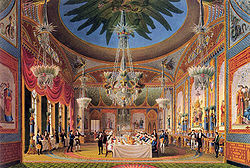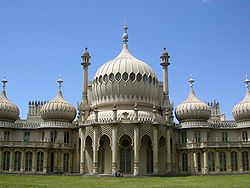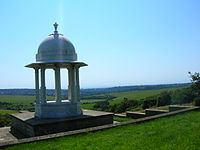- Royal Pavilion
-
"Brighton Pavilion" redirects here. For the electoral division, see Brighton Pavilion (UK Parliament constituency).
Coordinates: 50°49′23″N 0°08′15″W / 50.82306°N 0.1375°W
 The richly decorated Banqueting Room at the Royal Pavilion, from John Nash's Views of the Royal Pavilion (1826).
The richly decorated Banqueting Room at the Royal Pavilion, from John Nash's Views of the Royal Pavilion (1826).
The Royal Pavilion is a former royal residence located in Brighton, England. It was built in three campaigns, beginning in 1787, as a seaside retreat for George, Prince of Wales, from 1811 Prince Regent. It is often referred to as the Brighton Pavilion. It is built in the Indo-Saracenic style prevalent in India for most of the 19th century, with the most extravagant chinoiserie interiors ever executed in the British Isles.
Contents
History
The Prince of Wales, who later became King George IV, first visited Brighton in 1783, soon after achieving his majority. The seaside town had become fashionable through the residence of George's uncle, the Duke of Cumberland, whose tastes for cuisine, gaming, the theatre and fast living the young prince shared, and with whom he lodged in Brighton at Grove House. In addition, his physician advised him that the seawater would be beneficial for his gout. In 1786, under a financial cloud that had been examined in Parliament for the extravagances incurred in building Carlton House, London, he rented a modest erstwhile farmhouse facing the Steine, a grassy area of Brighton used as a promenade by visitors. Being remote from the Royal Court in London, the Pavilion was also a discreet location for the Prince to enjoy liaisons with his long-time companion, Mrs Fitzherbert. The Prince had wished to marry her, and did so in secrecy, as her Roman Catholicism ruled out marriage under the Royal Marriages Act.
In 1787 the designer of Carlton House, Henry Holland, was employed to enlarge the existing building, which became one wing of the Marine Pavilion, flanking a central rotunda, which contained only three main rooms, a breakfast room, dining room and library, fitted out in Holland's French-influenced neoclassical style, with decorative paintings by Biagio Rebecca. In 1801-02 the Pavilion was enlarged with a new dining room and conservatory, to designs of Peter Frederick Robinson, in Holland's office. The Prince also purchased land surrounding the property, on which a grand riding school and stables were built in an Indian style in 1803-08, to designs by William Porden that dwarfed the Marine Pavilion, in providing stabling for sixty horses.[1]
Between 1815 and 1822 the designer John Nash redesigned and greatly extended the Pavilion, and it is the work of Nash which can be seen today. The palace looks rather striking in the middle of Brighton, having a very Indian appearance on the outside. However, the fanciful interior design, primarily by Frederick Crace and the little-known decorative painter Robert Jones, is heavily influenced by both Chinese and Indian fashion (with Mughal and Islamic architectural elements). It is a prime example of the exoticism that was an alternative to more classicising mainstream taste in the Regency style.
Purchase by Brighton
After the death of George IV in 1830, his successor King William IV also stayed in the Pavilion on his frequent visits to Brighton. However, Queen Victoria disliked Brighton and the lack of privacy the Pavilion afforded her on her visits there (especially once Brighton became accessible to Londoners by rail in 1841) and the cramped quarters it provided her growing family. She purchased the land for Osborne House in the Isle of Wight, which became the summer home of the royal family. After her last visit to Brighton in 1845, the Government planned to sell the building and grounds. The Brighton Commissioners and the Brighton Vestry successfully petitioned the Government to sell the Pavilion to the town for £53,000 in 1850 under the Brighton Improvement (Purchase of the Royal Pavilion and Grounds) Act 1850.[2] The town used the building as assembly rooms. Many of the Pavilion's original fixtures and fittings were removed on the order of the royal household at the time of the sale, most ending up either in Buckingham Palace or Windsor Castle. Queen Victoria returned to Brighton large quantities of unused fittings in the late 1860s and George V and Queen Mary returned more after the First World War. Since the Second World War, the municipality of Brighton has spent a great deal of time, effort and money restoring the Pavilion to its state at the time of King George IV, encouraged by the permanent loan of over 100 items of furniture from Queen Elizabeth II in the 1950s, and has undertaken an extensive programme of restoring the rooms, reinstating stud walls, and creating replicas of some original fittings and occasionally pieces of furniture.
Tourism
The purchase of the Royal Pavilion from Queen Victoria, by Brighton, marked the beginnings of the site’s tourism dominance through the Royal Pavilion’s transition from a private residence to a public attraction under civic ownership. Today, the Royal Pavilion has around 400,000 people visiting it annually.[3]
References in culture
- In the 1970 film On a Clear Day You Can See Forever, many of the flashback scenes were filmed at the Royal Pavilion.
- In Richard Attenborough's 1969 film Oh! What a Lovely War, the Music Room was used for the scene where the Austrian Emperor signs the declaration of war against Serbia.
- In the short animation The Snowman, the snowman and the boy fly over what seems to be Brighton; the Royal Pavilion and the Palace Pier can clearly be seen.
- It serves as the seaside retreat of King Edward in the 1995 version of Richard III, set in a dystopian 1930s Britain.
- In the episode "Dish and Dishonesty" of Blackadder the Third, Blackadder tells the Prince, who has been granted money by Parliament, to "take out the drawings for that beach hut at Brighton!", a reference to the Pavilion.
- In contemporary artist Fiona Tan's film A Lapse of Memory, an eccentric old man lives alone in a deserted building (Royal Pavilion).
- In the music video of All Time High sung by Rita Coolidge the Royal Pavilion features, seemingly as an Indian palace.
External links
- The Royal Pavilion and Museums' official website
- Images of the Royal Pavilion
- "The Royal Pavilion and Museums Foundation". http://www.pavilionfoundation.org/.
- "Map Of Brighton - Brighton Map based information". http://www.mapofbrighton.com. Retrieved 2008-05-11.
References and notes
- ^ David Beevers, ed., The Royal Pavilion, Brighton: Souvenir Guide and Catalogue 2008:5.
- ^ Dale, Antony (1977). Brighton Town and Brighton People. Chichester: Phillimore. pp. 221. ISBN 0-85033-219-2.
- ^ "Brighton | Tourist Information | History & Heritage | The Royal Pavilion |." Brighton, Hotels, Accommodation, B&B, Tourist Information. Web. <http://tourism.brighton.co.uk/history/bodypage.asp?subheading=The+Royal+Pavilion&url=History&mainheading=6>.
Further reading
- Dinkel, John, 1983. The Royal Pavilion, Brighton
- Morley, John, 1983. The Making of the Royal Pavilion
- Musgrave, Clifford, 1951. Royal Pavilion: A Study in the Romantic
- Musgrave, Clifford, 1959. Royal Pavilion: An Episode in the Romantic
- Roberts, Henry D, 1939. The History of the Royal Pavilion, Brighton
- Rutherford, Jessica M.F., 2003. A Prince's Passion: The life of the Royal Pavilion.
Buildings and structures in Brighton and Hove Heritage Conservation areas · Listed buildings: Grade I · Grade II* · Grade II: A–B · C–D · E–H · I–L · M · N–O · P–R · S · T–V · W–Z




Places of worship List of places of worship (see list for links to individual articles) · List of demolished places of worship
Houses, flats
and mansionsChartwell Court · Embassy Court · Fife House · French Convalescent Home · 75 Holland Road · Marlborough House · New England Quarter · Ovingdean Rectory · Patcham Place · Pelham Institute · Preston Manor · Stanmer House · Sussex Heights · Van Alen Building · Western Pavilion
Crescents,
squares and
terracesAdelaide Crescent · Bedford Square · Belgrave Place · Bloomsbury Place · Brunswick Town · Hanover Crescent · Kemp Town · Lansdowne Square · Marine Square · Montpelier Crescent · New Steine · Norfolk Square · Norfolk Terrace · Old Steine · Oriental Place · Palmeira Square · Park Crescent · Pelham Square · Powis Square · Regency Square · Roundhill Crescent · Royal Crescent · Russell Square · Vernon Terrace · Wykeham Terrace
Commercial
buildingsAmex House · Brighton Forum, 95 Ditchling Road · Churchill Square · 20–22 Marlborough Place · 9 Pool Valley
Institutional and
civic buildingsBHASVIC · Brighton General Hospital · Brighton Town Hall · Hove Town Hall · Jubilee Library · Ovingdean Hall School · Royal Alexandra Hospital · Royal Sussex County Hospital · University of Sussex · Varndean College
Hotels and inns Hotels: Bedford · Grand (1984 bombing) · Metropole · Old Ship · Royal Albion · Royal York · Inns and pubs: The Cricketers · Evening Star · Freemasons Tavern · Hangleton Manor Inn · King and Queen · Royal Pavilion Tavern
Entertainment
and leisureAstoria (former) · Brighton Centre · Brighton Dome and Pavilion Theatre · Brighton Hippodrome (former) · Brighton Marina · Brighton Wheel · Duke of York's Picture House · Falmer Stadium · King Alfred Centre · Royal Pavilion · Saltdean Lido · Theatre Royal · Withdean Stadium · Museums: Booth Museum · Brighton Fishing Museum · Brighton Museum and Art Gallery · Brighton Toy and Model Museum · British Engineerium · Hove Museum and Art Gallery
Piers Brighton Pier · The Royal Suspension Chain Pier (demolished) · West Pier
Windmills Miscellaneous Barford Court · Chattri · Clock Tower · 11 Dyke Road · Foredown Tower · i360 (proposed) · Pepper Pot · St Dunstan's · Sassoon Mausoleum · Steine House (YMCA)
Related topics Ammonite Order · Bungaroosh · Cemeteries and crematoria · Mathematical tiles · Regency architecture · Architects: Charles Busby · John Leopold Denman · Thomas Lainson · John Nash · Basil Spence · Amon Henry Wilds · Amon Wilds
Categories:- Buildings and structures completed in 1815
- Buildings and structures in Brighton and Hove
- Country houses in Brighton and Hove
- Gardens in Brighton and Hove
- Royal residences in England
- Grade I listed buildings in Brighton and Hove
- Grade I listed houses
- Grade I listed palaces
- Museums in Brighton and Hove
- Historic house museums in Brighton and Hove
- Pavilions
Wikimedia Foundation. 2010.







